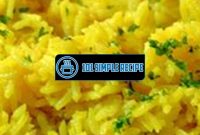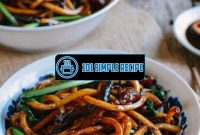Are you a fan of Chinese cuisine? One of the most popular dishes from this diverse culinary tradition is lo mein. But is it actually healthy? In this article, we will delve into the nutritional value of lo mein and explore its health benefits and drawbacks. Read on to discover whether indulging in a delicious plate of lo mein fits into your balanced diet!
The Nutritional Content of Lo Mein
When it comes to exploring the nutritional content of lo mein, it is important to take a closer look at the macronutrient composition and calorie content of this popular Chinese dish. Understanding the impact it may have on your health is crucial in making informed dietary choices.
The Role of Carbohydrates in Lo Mein
Carbohydrates play a significant role in the nutritional profile of lo mein. This dish primarily consists of noodles made from wheat flour, which are a rich source of complex carbohydrates. These carbohydrates provide the necessary energy your body needs to function effectively throughout the day.
The complex carbohydrates present in lo mein are digested at a slower rate compared to simple sugars, ensuring a steady release of energy. This can help prevent blood sugar spikes and crashes, promoting better overall blood sugar control. Additionally, carbs act as a vital fuel source for your brain and muscles, making them essential for optimal cognitive and physical performance.
The Protein Content in Lo Mein
Protein is another important macronutrient found in lo mein. Generally, this dish incorporates various sources of protein such as chicken, beef, shrimp, or tofu. Protein is essential for the growth, repair, and maintenance of tissues in your body, including muscles, skin, and hair.
Having a sufficient protein intake can also help you feel full for longer periods, reducing the likelihood of overeating. This can be particularly beneficial if you are trying to manage your weight. Additionally, protein plays a crucial role in immune function and the production of enzymes and hormones, contributing to optimal bodily functions. ⚕️
The Fat Content in Lo Mein
While lo mein generally contains a moderate amount of fat, the specific type of fat used can influence its overall healthiness. Oils such as sesame or vegetable oil are commonly used in the preparation of lo mein, providing a source of unsaturated fats. These healthy fats are important for various bodily functions and can help reduce the risk of heart disease.
However, it’s important to consume these fats in moderation as they are high in calories. Excessive intake can contribute to weight gain and other health issues. To keep the fat content of lo mein in check, opt for lighter sauces and request for less oil when ordering from restaurants. Alternatively, you can prepare a homemade version using minimal oil and incorporating lean protein options.
Overall, lo mein can be a part of a healthy and balanced diet when consumed in moderation and prepared with nutritious ingredients. By being mindful of portion sizes and making conscious choices regarding the type and amount of fats included, you can enjoy this flavorful dish without compromising your health goals. Bon appétit! ️
Vitamins and Minerals in Lo Mein
When it comes to the question of whether lo mein is healthy, it’s important to take a closer look at the vitamins and minerals present in this popular Chinese dish. Lo mein is typically made with wheat noodles, vegetables, and some form of protein, such as chicken or tofu. These ingredients contribute to the overall nutritional value of the dish and provide a range of essential nutrients that can benefit your health.
The Role of Vitamin A in Lo Mein
Vitamin A plays a crucial role in maintaining good vision, promoting a healthy immune system, and supporting cell growth. In lo mein, you can find vitamin A in the form of carrots, bell peppers, and other colorful vegetables that are commonly used in this dish. These vegetables not only add flavor and texture but also bring the added benefit of a good dose of vitamin A.
Vitamin A helps to improve your vision, boost your immune system, and maintain healthy skin.
The Importance of Vitamin C in Lo Mein
Vitamin C is another essential nutrient found in lo mein that offers a range of health benefits. This vitamin acts as an antioxidant, protecting your cells from damage caused by harmful free radicals. It also plays a key role in collagen production, which is essential for healthy skin, blood vessels, and connective tissues. In lo mein, vegetables like broccoli, mushrooms, and snow peas are excellent sources of vitamin C.
Vitamin C boosts your immune system, promotes healthy skin, and supports wound healing.
The Contribution of Iron in Lo Mein
Iron is an important mineral that helps in the production of hemoglobin, a protein responsible for carrying oxygen to your body’s tissues. It also aids in energy production and plays a role in maintaining a healthy immune system. Lo mein often includes protein sources like chicken or tofu, which are both good sources of iron. Additionally, dark leafy greens such as spinach or bok choy can provide a boost of this essential mineral.
Iron helps to prevent fatigue, supports the immune system, and aids in oxygen transport.
In conclusion, lo mein can be a healthy and satisfying meal choice, thanks to the vitamins and minerals it contains. The vitamin A from colorful vegetables, vitamin C from broccoli and mushrooms, and iron from protein sources and leafy greens all contribute to the nutritional value of this delicious dish. So go ahead and enjoy your plate of lo mein knowing that it can provide you with vital nutrients to support your overall health!
If you’re looking for a healthy recipe, try making weight loss recipes that incorporate nutritious ingredients and have lower calorie content.
Choosing Healthy Ingredients for Lo Mein
Choosing healthy ingredients is essential in ensuring that your lo mein dish is a nutritious and wholesome meal. By carefully selecting the components of your dish, you can make lo mein a healthy and delicious option for your next meal. Let’s explore some key factors to consider when choosing ingredients for your lo mein.
The Impact of Vegetable Selection on Lo Mein
Vegetables play a crucial role in the overall healthiness of your lo mein dish. They are packed with essential vitamins, minerals, and dietary fiber that contribute to a balanced diet. When choosing vegetables for your lo mein, opt for a colorful variety to ensure that you are getting a wide range of nutrients. Include vegetables such as bell peppers, broccoli, carrots, and snap peas to add crunch, flavor, and nutritional value to your dish.
Including broccoli in your lo mein provides a good source of vitamin C and dietary fiber.
Carrots are an excellent addition as they are loaded with beta-carotene, which is beneficial for eye health.
️ Adding bell peppers not only brings a pop of color but also provides vitamin A and vitamin C.
Snap peas are a great choice as they contribute to your daily intake of vitamin K and folate.
Choosing Lean Proteins for Lo Mein
Protein is an essential macronutrient that contributes to the growth and repair of tissues in our bodies. When selecting proteins for your lo mein, opt for lean options to keep your dish healthy. Lean proteins such as chicken breast, shrimp, tofu, or lean cuts of pork are excellent choices. These proteins are low in saturated fats and provide a good source of nutrients.
Chicken breast is a lean protein option that is low in calories and high in protein content.
Shrimp is another great choice as it is low in calories but high in omega-3 fatty acids, which are beneficial for heart health.
Tofu is an excellent option for vegetarians or those looking to reduce their meat consumption. It is a complete protein source and contains all essential amino acids.
If you prefer pork, opt for lean cuts such as tenderloin or loin chop to reduce saturated fat intake.
Opting for Whole-Wheat Noodles in Lo Mein
The type of noodles you choose for your lo mein can significantly impact its nutritional value. Instead of traditional white noodles, consider using whole-wheat noodles. Whole-wheat noodles are made from whole grains and retain their natural fiber and nutrients, making them a healthier alternative.
Whole-wheat noodles are an excellent source of dietary fiber, which aids in digestion and helps maintain a healthy weight.
Unlike refined white noodles, whole-wheat noodles have a lower glycemic index, making them a suitable option for individuals managing their blood sugar levels.
Whole-wheat noodles provide a nutty and flavorful taste, adding depth to your lo mein dish.
By choosing the right ingredients for your lo mein, you can transform it into a wholesome and nutritious meal. Remember to incorporate a variety of colorful vegetables, opt for lean proteins, and consider using whole-wheat noodles for optimal health benefits. Enjoy your flavorful and healthy rendition of lo mein!
For a refreshing beverage option, check out this punch bowl recipe. It’s perfect for parties or gatherings and can be customized with different flavors and fruits.
The Role of Cooking Methods in Lo Mein’s Healthiness
When it comes to the healthiness of lo mein, the cooking method plays a significant role. Different cooking techniques can either enhance or diminish the health benefits of this popular Chinese dish. By understanding the impact of cooking methods, you can make more informed choices to ensure a healthier lo mein option. Let’s explore some key cooking methods and their effects on the healthiness of lo mein.
Stir-Frying vs. Deep-Frying for Lo Mein
One of the most important considerations when it comes to cooking lo mein is choosing between stir-frying and deep-frying. Stir-frying involves quickly cooking the ingredients over high heat, using minimal oil. This cooking method helps retain the nutrients in the vegetables and proteins, making it a healthier choice.
On the other hand, deep-frying involves submerging the ingredients in hot oil, resulting in a crispy texture. While deep-fried lo mein may be more indulgent and flavorful, it also absorbs a significant amount of oil, adding extra calories and unhealthy fats.
Health Tip: Opting for stir-fried lo mein can help reduce the overall calorie and fat content of the dish.
Using Healthy Cooking Oils in Lo Mein
Another factor that influences the healthiness of lo mein is the choice of cooking oil. It’s important to select a healthy cooking oil that can withstand high temperatures without breaking down and forming harmful compounds. Some healthy options include olive oil, avocado oil, and coconut oil.
Using these healthier oils can help promote cardiovascular health and provide essential fatty acids. Avoiding oils high in trans fats, such as vegetable shortening or hydrogenated oils, is crucial for maintaining a nutritious lo mein dish.
Health Tip: Substitute unhealthy oils with healthier alternatives to make your lo mein a more nutritious option.
Controlling Sodium Levels in Lo Mein
Sodium, commonly found in soy sauce and other condiments, can significantly impact the healthiness of your lo mein dish. Excessive sodium intake can lead to increased blood pressure and other health concerns. Therefore, it’s essential to control sodium levels when preparing lo mein.
One way to do this is by using reduced-sodium soy sauce or tamari, which can help lower the overall sodium content in your dish without compromising flavor. Additionally, incorporating more fresh vegetables, lean proteins, and herbs can enhance the taste of lo mein while reducing the reliance on high-sodium condiments.
Health Tip: By monitoring your sodium intake and making smart ingredient choices, you can enjoy a healthier version of lo mein.
By considering the cooking methods used, the choice of healthy cooking oils, and controlling sodium levels, you can make lo mein a healthier option without sacrificing taste. Experiment with different techniques and ingredients to find the perfect balance between flavor and nutrition in your homemade lo mein.
Anchovy paste is often used as an ingredient in various recipes, including White Castle burgers. It adds a rich umami flavor to the dish.
Healthier Alternatives to Traditional Lo Mein
When it comes to enjoying a delicious Chinese takeout, lo mein has always been a favorite choice. However, if you’re watching your health or trying to stick to a specific diet, you may be wondering if lo mein is a healthy option. Fortunately, there are a few simple ways to make this classic dish even healthier without compromising on taste. In this article, we will explore innovative and nutritious substitutions for traditional lo mein ingredients. Let’s dive in!
Replacing Noodles with Vegetable “Noodles”
A fantastic way to boost the nutritional value of your lo mein dish is by replacing regular noodles with vegetable “noodles.” These noodles are made from vegetables like zucchini, carrots, or sweet potatoes, offering a lower carbohydrate and calorie content. Not only does this substitution increase your daily vegetable intake, but it also adds more fiber, vitamins, and minerals to your meal.
To make vegetable noodles, you can use a spiralizer or julienne peeler to create thin strips that closely resemble traditional noodles. Once you have your vegetable noodles ready, simply stir-fry them with your favorite vegetables, proteins, and sauces for a healthy and satisfying dish.
Exploring Gluten-Free Options for Lo Mein
If you’re following a gluten-free diet or have gluten sensitivities, you don’t have to miss out on enjoying a delicious plate of lo mein. Traditional lo mein noodles are made from wheat flour, which contains gluten. However, there are plenty of gluten-free alternatives available in the market today.
One popular gluten-free option is using rice noodles or gluten-free noodles made from ingredients like brown rice or quinoa. These noodles offer a similar texture and taste to traditional lo mein noodles but are suitable for those with gluten restrictions. Additionally, you can also try using spiralized vegetables as mentioned earlier or even bean sprouts as a crunchy and gluten-free alternative.
Experimenting with Low-Sodium Sauces for Lo Mein
One of the biggest concerns with traditional lo mein is the high sodium content found in the sauces. Excessive sodium intake can lead to health issues such as high blood pressure. However, you can still enjoy a flavorful lo mein dish by experimenting with low-sodium sauces.
Instead of using store-bought sauces, which are often loaded with sodium, consider making your own sauces using low-sodium soy sauce, coconut aminos, or tamari. These alternatives offer the same savory taste without the excessive sodium. You can also enhance the flavor by adding spices like garlic, ginger, or chili flakes for a tasty kick. ️
Furthermore, try incorporating more fresh herbs and spices, such as cilantro, basil, or turmeric, into your dish for added health benefits and flavor. This way, you’ll have full control over the ingredients and can tailor the sauce to suit your preferences and dietary needs.
In conclusion, by making a few simple substitutions and being mindful of the ingredients you use, you can transform a traditional lo mein dish into a healthier yet equally delicious alternative. Whether it’s replacing noodles with vegetable “noodles,” exploring gluten-free options, or experimenting with low-sodium sauces, there are plenty of ways to enjoy this Chinese favorite guilt-free. So go ahead and get creative in the kitchen – your taste buds and your health will thank you!
Thank you for taking the time to read our article on whether or not lo mein is healthy. We hope that we were able to provide you with valuable insights and information. Don’t forget to check back later for more articles on healthy eating and delicious recipes. Stay informed and stay healthy!
Frequently Asked Questions
Here are some frequently asked questions about the healthiness of lo mein:
| No. | Questions | Answers |
|---|---|---|
| 1. | Is lo mein a healthy dish? | Lo mein can be a healthy option if made with the right ingredients and in moderation. It’s important to choose whole wheat noodles, load up on vegetables, and opt for lean proteins. Avoid excessive amounts of oil and sauces high in sodium. Remember, portion control is key! |
| 2. | What are some healthier alternatives to traditional lo mein? | If you’re looking for a healthier alternative, try making “zoodles” or spiralized vegetables as the base instead of noodles. You can also use whole grain or gluten-free pasta. Another option is to use low-sodium soy sauce or tamari instead of traditional sauces. |
| 3. | Can I make lo mein at home? | Absolutely! Making lo mein at home allows you to have full control over the ingredients and portion sizes. Plus, it can be a fun and creative cooking experience. Just make sure to follow a healthy recipe and use fresh, high-quality ingredients. |
| 4. | How can I incorporate more vegetables into my lo mein? | Adding a variety of colorful vegetables such as bell peppers, broccoli, carrots, and snap peas can boost the nutritional value of your lo mein. You can also experiment with different herbs and spices to enhance the flavor. |
| 5. | Is lo mein suitable for vegetarians or vegans? | Lo mein can be easily adapted for vegetarians and vegans. Simply substitute meat or animal-based ingredients with plant-based proteins such as tofu, tempeh, or seitan. Make sure to use vegetable broth instead of meat-based broth as well. |
| 6. | How can I make my lo mein more nutritious? | To make your lo mein more nutritious, consider adding sources of healthy fats such as avocado or nuts. You can also include sources of lean protein like shrimp, chicken breast, or edamame. Additionally, opting for whole wheat noodles or adding fiber-rich ingredients like beans or legumes can increase the nutritional value. |
Closing Thoughts
We hope this article has shed some light on the question of whether lo mein is healthy. It’s important to remember that the healthiness of this dish largely depends on the ingredients and cooking methods used. With careful choices, lo mein can be a delicious and balanced meal option. Don’t be afraid to get creative in the kitchen and experiment with different ingredients to make your lo mein even healthier. Thanks again for reading, and we’ll see you next time!
Jump to Recipe
Is Lo Mein Healthy
Discover whether lo mein is a healthy dish and learn tips for making it healthier
- 8 oz of whole wheat lo mein noodles
- 2 cups of mixed vegetables (bell peppers, broccoli, carrots)
- 1 tablespoon of sesame oil
- 2 cloves of garlic (minced)
- 1/4 cup of low-sodium soy sauce
- 1 tablespoon of honey
- 1 tablespoon of cornstarch
- 1/4 cup of water
- Optional: 8 oz of shrimp or chicken breast (cooked and sliced)
- Bring a large pot of water to a boil and cook the lo mein noodles according to the package instructions. Drain and set aside.
- In a small bowl, whisk together the soy sauce, honey, cornstarch, and water. Set aside.
- Heat the sesame oil in a large skillet or wok over medium-high heat. Add the minced garlic and cook until fragrant. Add the mixed vegetables and stir-fry for 3-4 minutes, or until crisp-tender.
- Add the cooked lo mein noodles to the skillet with the vegetables. Pour the sauce over the noodles and vegetables. Toss everything together until well coated and heated through.
- If desired, add cooked shrimp or sliced chicken breast to the skillet and cook for an additional 2-3 minutes, or until heated through.
- Divide the lo mein onto plates or bowls and serve hot. Enjoy!






